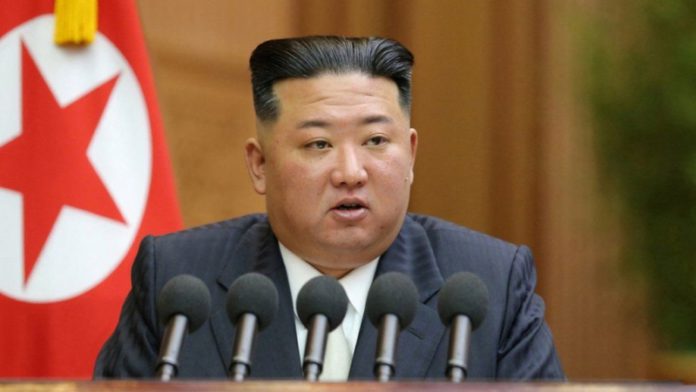North Korean dictator Kim Jong Un cried as he called on women to have more children, saying that it was their duty to halt the country’s declining birth rate in order to strengthen national power.
In his seemingly highly choreographed emotional plea, the authoritarian leader was seen dabbing his eyes with a handkerchief while addressing thousands of women gathered at a National Mothers’ Meeting in Pyongyang on Sunday.
‘Preventing a decline in birth rates and good childcare are all of our housekeeping duties we need to handle while working with mothers,’ Kim said at the event, while also urging them to instil the values of his communist party in their children.
Many in the large audience – made up of women dressed in traditional multi-coloured garments – openly wept along with their leader.
But it wasn’t all a sombre affair. Pictures released by North Korea’s state media also showed the adoring crowd clapping and cheering Kim as he waved back from his seat, flanked by male officials in suits and military uniform.
The event – the first National Mothers’ Meeting in 11 years – was put on amid a fall in the isolationist state’s birth rate, which has evidently prompted concern among the DPRK’s (Democratic People’s Republic of Korea) top officials.
Addressing the audience as ‘Dear Mothers’, Kim told them ‘we are confronted with a host of social tasks that our mothers should join to tackle’.
‘These tasks,’ he said, ‘include bringing up their children so that they will steadfastly carry forward our revolution, eliminating the recently-increasing non-socialist practices, promoting family harmony and social unity, establishing a sound way of cultural and moral life, making the communist virtues and traits of helping and leading one another forward prevail over our society, stopping the declining birth rate, and taking good care of children and educating them effectively.
‘These belong to our common family affairs, which we need to deal with by joining hands with our mothers,’ he added.
He went on to say that ‘in view of our mothers’ position and role in their families and society’, his government viewed the meeting of mothers as ‘no less important than a party congress or a plenary meeting of the Party Central Committee.’
Getting a detailed idea of North Korea‘s population trends is extremely difficult because of the limited statistics it discloses.
The last census North Korea released was in 2008, which showed its population stood at 24 million. Estimates now suggest 25.7 million people inhabit the country.
However, South Korea‘s government assesses that the North’s fertility rate has declined steadily for the past 10 years.
That is a concerning development for the socialist country that depends on mobilised labour to help keep its broken, heavily sanctioned economy afloat.
It also follows a ‘military first’ approach which prioritises the Korean People’s Army when it comes to the allocation of resources.
It is the country with the highest number of military and paramilitary personnel per capita, and its active-duty army of 1.28 million soldiers is the fourth largest in the world, despite having the world’s 56th largest population.
According to South Korea’s government statistics agency, North Korea’s total fertility rate, or the average number of babies expected to be born to a woman over her lifetime, was 1.79 in 2022, down from 1.88 in 2014.
Even the figures released by North Korea itself in 2008 suggested a slow-down in population growth, which otherwise had risen fairly consistently since a drop caused by the Korean War in the early 1950s.
Between 1993 and 2008, the country reported a per-annum growth rate of 0.84 per cent. Between 1963 and 1993, that figure had been 2.04 per cent.
However, the earlier figure does not paint the full picture, with the average number of children born to women in North Korea decreasing from 6.5 in 1966 to 2.5 in 1988.
This was put down to women marrying later, urbanisation, limited housing space in the country and the expectation for women to work – all factors that analysts say have contributed to lower birth rates in other countries.
But the decrease in fertility since the 1990s has also been caused by famine, as well as a post-war push to slow population growth in the 1970s and 80s.

